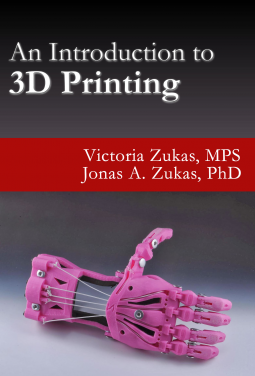
An Introduction to 3D Printing
by Victoria Zukas and Jonas A Zukas
This title was previously available on NetGalley and is now archived.
Send NetGalley books directly to your Kindle or Kindle app
1
To read on a Kindle or Kindle app, please add kindle@netgalley.com as an approved email address to receive files in your Amazon account. Click here for step-by-step instructions.
2
Also find your Kindle email address within your Amazon account, and enter it here.
Pub Date May 06 2015 | Archive Date Jul 06 2015
Description
This book is aimed at an audience consisting of two kinds of readers. The first is people who are curious about 3D printing and want more information without necessarily getting deeply into it. For this audience, the first two chapters will be of greatest interest. They provide an overview of 3D print technology. They also serve to take the confusion out of the jargon and make sense out of such shortcuts as SLA, FFM, FFF, FDM, DLP, LOM, SLM, DMLS, SLS, EBM, EBAM, CAD and others. They describe the basic processes, the materials used and the application of the technology in industry, space, medicine, housing, clothing and consumer-oriented products such as jewelry, video game figures, footwear, tools and what must now seem like an infinity of bunnies, eagles and busts of Star Wars and Star Trek figurines in a dazzling array of colors.
This book also addresses the needs of people new to the field who require information in a hurry. Chapter 3 serves as a guide to generating a 3D model by reviewing scanning methodology, the various types of software available to create a model and the steps needed to insure a useful printed object from the 3D model. The chapter has numerous references which, together with the information in the text, will help one find quickly any additional information available on the internet.
Victoria E. Zukas received her bachelor's degree in Interactive Media and Game Development in 2009 from Worcester Polytechnic Institute. She completed her Masters of Professional Studies in Digital Media in 2013 at Northeastern University. She has spent her time since then working as a Freelance Graphic Designer on a number of projects. Her background is mainly focused on creating 3D models for video games. Her published game BLASTiators can be found on the Google Play store.
Jonas A. Zukas, received his doctorate in engineering mechanics from the University of Arizona. He is widely known for his work in numerical modeling of the behavior of structures and materials at high rates of strain. He has co-authored and edited a number of books and conference proceedings and is the author of the monograph Introduction to Hydrocodes published by Elsevier. He is co-developer of the ZeuS code for the analysis of impact phenomena and was a Fellow of the American Society of Mechanical Engineers, a Senior Member of the American Institute of Aeronautics and Astronautics and a member of the American Academy of Mechanics
A Note From the Publisher
Keywords: 3D Printing, 3D Software, 3D Hardware, Printing Materials, Scanning, 3D Modeling, Jewelry, Medicine, Housing, Space
Marketing Plan
eBook,Print
Available Editions
| EDITION | Ebook |
| ISBN | 9781622878970 |
| PRICE | $24.95 (USD) |
Average rating from 13 members
Featured Reviews
 Concert K, Reviewer
Concert K, Reviewer
3D Printing is something that fascinates me. It's amazing to see what can be made on a printer and how it can help people. I'd love to have a 3D printer myself. Not that I have any idea what I'd make with it, but it would be fun. This book is for people who are curious about printing and want more information without going too in depth as well as people who are new to the field who need information and quickly.
The book has a lot of great information in it, with a lot of photos to go along with it. At the end of each section there is also resources that you can check out if you are looking to find out more about each of the areas of 3D printing. Some of the things shown in this book are amazing - from figurines to castles to prosthetics.
This book was very interesting and I am still hoping that some day I'll be making something with a 3D printer!
I received a free e-copy of this book in order to write this review.
review will be posted august 14
 Paula D, Reviewer
Paula D, Reviewer
I am a newbie to 3D Printing. This book was very informative and instructional, full of clearly explained facts and processes. The authors have a friendly, approachable style that explains jargon rather than using it to confound the neophyte reader. There is no condescension here, only an excellent and comprehensive discussion of the different types of 3D printing and what's involved in 3D Printing (hardware, software, materials, etc.)
The authors include a number of references with each chapter. They also list Open Source alternatives (such as Blender software for 3D modeling) which is very useful for the financially challenged.
Overall an excellent educational resource for 3D Printing novices.
 Leyla J, Reviewer
Leyla J, Reviewer
This book really blow me away, didn't really know much about 3D printing apart from the fact the architects use it. This actually explains all the other things that it can be used for, how it works - and it goes further into the technical side. The book is easy to read and understand even for a 64year old. The future looks both scary and exciting - the good that this does now, and what may be able to be achieve in the future, is mind boggling. It is not often that a find a book on technology that I can understand. The book would also be useful for people who want a more technical information, with references and where to go to sites.
This book was supplied to me in return for a honest and unbiased review.
Readers who liked this book also liked:
Jennifer Chiaverini
General Fiction (Adult), Parenting & Families, Women's Fiction


















